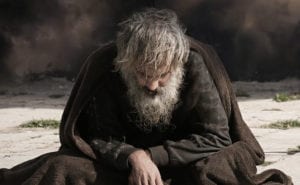
Does it seem strange to you – in this post-feminist, dystopian, Katniss-loving movie era – that a remarkably traditional version of Cinderella is not only on our screens, but raking in the big bucks?
Disney’s live action retelling of its own animated classic, itself based primarily on the Charles Perrault account of the old tale, earned around $70 million over its opening weekend.
Not bad for a remake.
Fairy tales are the real stayers of popular culture, bouncing back just when you think they’ll take a break. Like the poor, fairy tales are always with us, in one form or another, whether it’s a kick-arse steampunk version of Hansel and Gretel, or the innovative re-appraisal of The Snow Queen that is Frozen.
But what makes Cinderella stand out is its faithfulness to the original 1950 version. There’s a nasty step-mother and her spoilt daughters, a pumpkin-turned-coach, even industrious dressmaking mice (and wouldn’t every girl like a few of those… or maybe that’s just me).
All that’s missing is the pre-beehive hairdo and long gloves.
It could be hackneyed but it’s actually charming. And it fairly wallows in its old-timey romanticism. There are plenty of piercing gazes and heaving breasts, gorgeously shot and crisply performed. Even this cynical old viewer was seduced by the sumptuousness of the production. Turns out I’m as smitten as the next five-year-old by a pair of pretty shoes.
In contrast, most fairy tales for the new generation are populated by witty women of action (Ever After, Ella Enchanted, Tangled) or dig out the hidden past trauma of those misunderstood evil queens (as in the wonderful Maleficent and the aforementioned Frozen).
Meanwhile, the handsome prince is all too often a cad, while the humble stable boy turns out to be ‘the one’.
It is unavoidable that fairy tales evolve with time, and take on the flavor of their age, because these tales are a way of reflecting back – in mythical terms – what is happening in our world. If traditional fairy tale women are passive, dependent on a shining prince to lift them out of the mire, that’s because for centuries women were shackled to a system that made them exactly that – pawns in the world of men. Catching a rich husband really could save your life. Today’s sassy go-getters are a welcome reflection of change – as likely to receive true love’s kiss from their sister or peasant boyfriend as from a prince.
But regardless of these variations, some things stay the same. There is an inward structure to fairy tales that seems bullet-proof and is perhaps the reason for their ongoing fascination. It’s not just the element of magic, although that is indispensible. It is a pre-occupation with good and evil, with punishment and redemption, and – above all – reconciliation. The ‘happily ever after’ part of the equation. If that’s not there, I dare say it’s not a fairy tale.
There is a human longing for justice and restoration that finds satisfaction in these tales: the dragon slain, the misunderstanding resolved, the kingdom put to rights under the wise king. Even the hope that flies out of Pandora’s box after a catalogue of terrible evils. Tolkien called this a ‘eucatastrophe’ – a ‘good’ catastrophe that characterizes all fairy tales. He wrote:
“It is the mark of a good fairy-story, of the higher or more complete kind, that however wild its events, however fantastic or terrible the adventures, it can give to child or man that hears it, when the ‘turn’ comes, a catch of the breath, a beat and lifting of the heart, near to (or indeed accompanied by) tears, as keen as that given by any form of literary art, and having a peculiar quality.”[i]
The theme of restoration after tragedy is something with which Christian readers will be more than familiar. In Jesus’ death and resurrection, and the hope for his kingdom to come fully on his return, we have the ultimate ‘eucatastrophe’.
This is not meant to imply that the basis of Christian faith is just another fairy tale, as the New Atheists suggest; rather, that the mythmakers and fairy tale writers throughout history have intuited that humans yearn for a savior, and to see evil punished, goodness recognised and order restored by a wise ruler. Their stories foreshadow or hark back to the cross, where we see historical and ontological truth collide with the mythic truth at which those tales can only hint.
Two other well-known Christian writers drew the same conclusion. G K Chesterton and C S Lewis both wrote extensively on the significance of myth and fairy tale in Western culture. And they both drew parallels with the gospel of Jesus.
From Chesterton: “Demeter wanders over a stricken world looking for a stolen child; Isis stretches out her arms over a stricken world in vain to gather the limbs of Osiris; and there is lamentation upon the hills for Atys and through the woods for Adonis. There mingles with all such mourning the mystical and profound sense that death can be a deliverer and an appeasement; that such death gives us a divine blood for a renovating river and that all good is found in gathering the broken body of a god. We may truly call these foreshadowings; so long as we remember that foreshadowings are shadows.”[ii]
And Lewis: “Now the story of Christ is simply a true myth: a myth working on us in the same way as the others, but with this tremendous difference that it really happened: and one must be content to accept it in the same way, remembering that it is God’s myth where the others are men’s myths: i.e. the Pagan stories are God expressing Himself through the minds of poets, using such images as He found there, while Christianity is God expressing Himself through what we call ‘real things’.”[iii]
These stories cast a shadow, which finds flesh and blood in Jesus. Or as Paul puts it, “the mystery that has been kept hidden for ages and generations, but is now disclosed to the Lord’s people” (Col 1:26).
So when you take your kids to see Cinderella, dwell on this: a fairy tale happy ending only lasts until the next witch or beast comes along. But in Christ, we have a joyful restoration that is eternal.
[i] J R R Tolkein, “On Fairy Stories”, http://brainstorm-services.com/wcu-2004/fairystories-tolkien.pdf, 23.
[ii] G K Chesterton, The Everlasting Man (San Francisco: Ignatius, 2008), 114.
[iii] C S Lewis, “Letter to Arthur Greeves,” October 18, 1931, quoted in Gene E. Veith, Jr., Reading Between the Lines: A Christian Guide to Literature (Wheaton: Crossway Books, 1990), 138.















